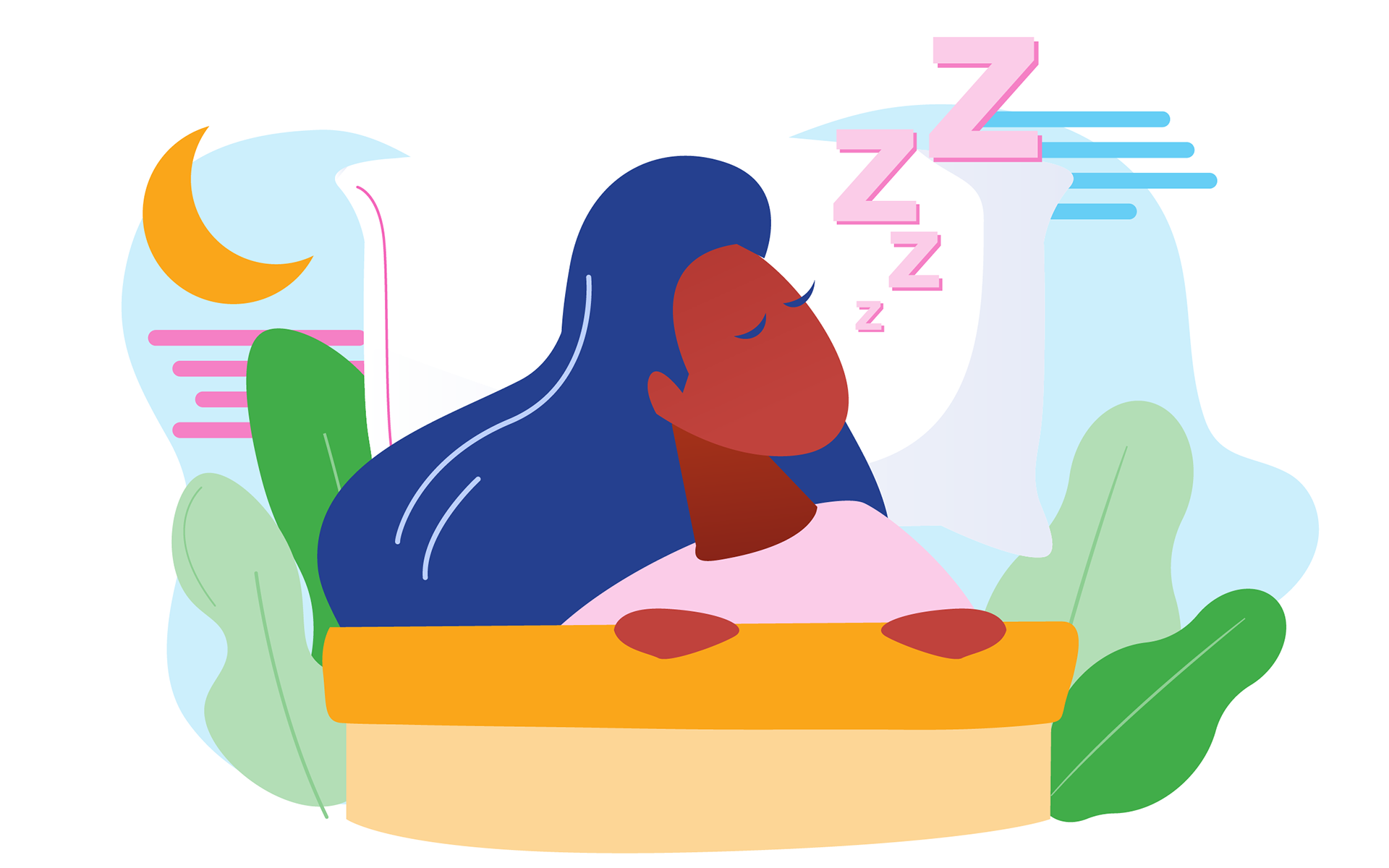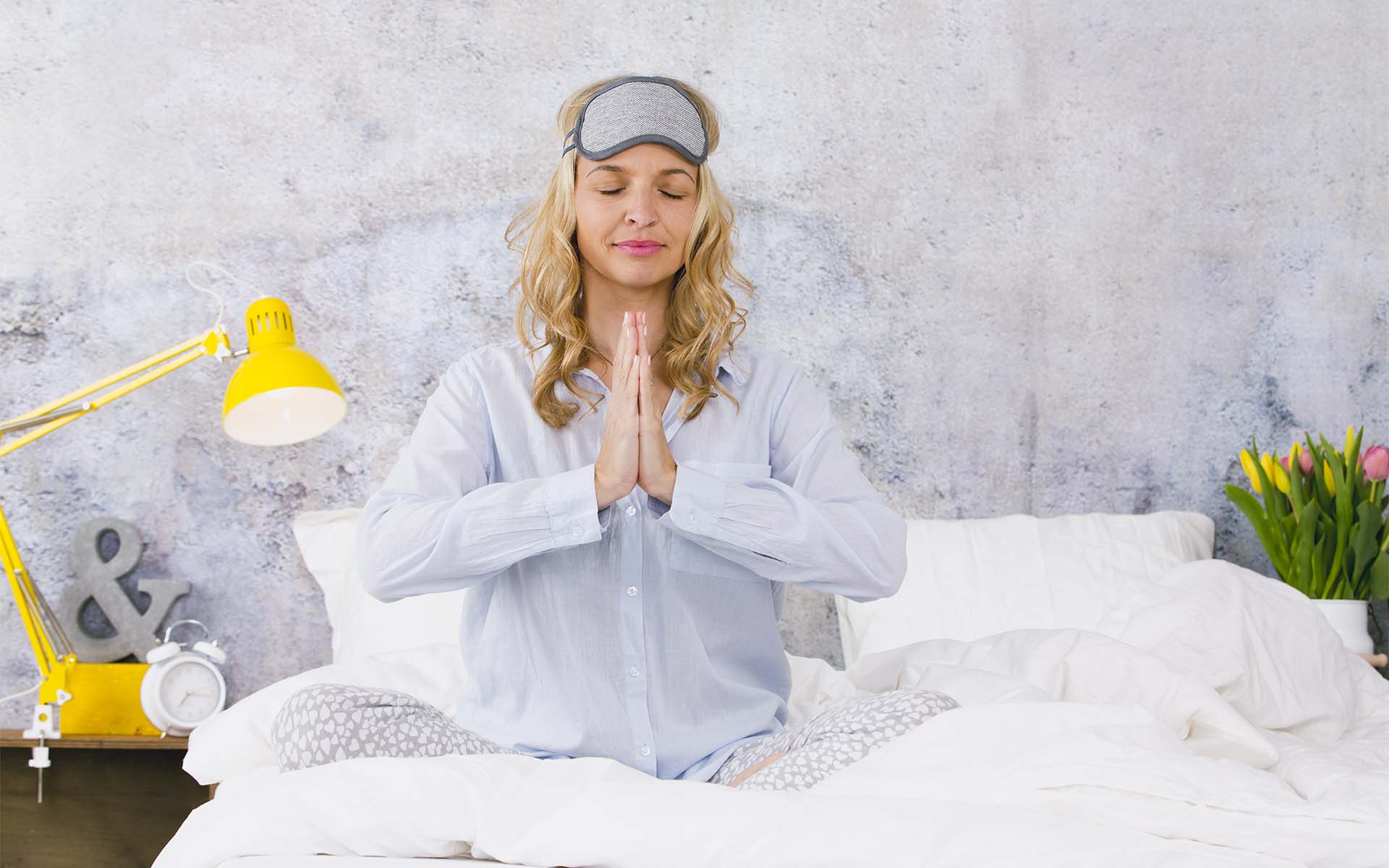Hi, I’m Sara Ivanhoe—yoga director at the University of Southern California where I teach a five-week course on sleep. What I’m going to be teaching you now is a short sequence of gentle movements and breathing techniques to help you wind down at the end of the day and prepare for sleep.
You don’t need anything special for this practice. If you want, you can grab a pillow off your bed or off the sofa to sit on. I’ve got a nice big cushion, but as you can see, I’m not in yoga clothes or even on a yoga mat. You just need a nice, comfortable place where you know you can spread out.
A Gentle Stretch Sequence for Sleep
1. Begin by sitting comfortably—sit up tall and allow your eyes to close.
2. Take a few deep breaths in and out through your nose.
3. Set your intention to let go of the day, to practice releasing and relaxing on command and giving yourself permission to sleep.
4. Now, please allow your eyes to open and interlace your fingers. Turn the palms of your hands away from you and reach your arms up over your head…and release.
5. Interlace your fingers the other way here with your other hand on top. Then, press your palms toward the ceiling. When you’ve got your arms stretched, take a moment. Close your eyes and deepen your breathing.
6. Open your eyes and release your hands. Now, allow yourself to come into a gentle side lean. You may want to rock forward or backward. Your goal is to try to erase tension from the body.
7. And then come back up to a seated position, and we’ll lean on the other side. Often I move a little until I find a tight spot. And then once I find that tight spot, I try to send some breath into the tight spot to clear it out.
8. Come all the way up to your sitting position. And then I’m just going to have you change the crossing of your legs so we’re balanced here. Put the other foot in front and take a gentle, seated twist. So I’m just going to hold on to whatever I can hold on to, and use that to twist. I inhale to get nice and tall, and then I exhale to twist my upper body with my eyes closed. Every time you approach any stretch, see what parts of your body can consciously soften and let go.
9. Take one more breath here, and move back to a neutral position. Whenever you’re letting go of a stretch, you don’t want to pop out of it. We want to let go of all our stretches mindfully.
10. So then, if it feels good to move, flow into the twist on the other side. Again, in all stretches, find a comfortable spot, close your eyes, relax, release some tension, and breathe.
11. Release the twist.
Left Nostril Breathing to Wind Down Before Bed
We’re going to move into a breathing technique that will help you wind down and relax. It’s called left nostril breathing.
1. On your right hand, take your middle and index finger and bend them into the palm of your hand. We’re going to be using both the thumb and ring finger to manipulate our nostrils. We’ll use them to close the nostrils one at a time.
2. For this technique, we’re going to be breathing in through the left nostril and out through the right nostril. We’re creating a circular breathing rhythm where the breath always goes in through the left side—the left channel of the body—and out through the right side.
3. Let’s start with our mouth closed. Take a deep breath in through both nostrils just to clear our palettes with the breath. So, with your mouth closed, breathe in through the nose, and then out through your nose.
4. Now, let’s begin the circular breathing. With your thumb, close off the right nostril and inhale through the left nostril.
5. When you get to the top of the breath, you can use your ring finger to close your left nostril, and then exhale through the right nostril.
6. Then we switch sides. Close off the right nostril with the thumb, and inhale through the left. Close your left nostril with your ring finger, and exhale through the right.
7. Repeat this cycle as many times as you’d like.
8. When you’re ready, open your eyes and move your hand back down to your thigh. And through both nostrils now, inhale and exhale.
Mindful Movement for Relaxation
1. Now, still seated in a cross-legged position, I’m going to have you take your cushion (if you have one) and place it under your belly. We’re going to do a nice, easy forward bend. This is not for our flexibility, just for our relaxation.
2. Bend forward, letting your head drop and turn to one side. We’re just going to relax here, supported by a pillow or our thighs. You can also let your eyes close.
3. Start to feel the back of your neck release. Send your breath into the back of the neck.
4. Open your eyes and come all the way back up to sit. For the last time we’re going to change the crossing of the legs. So switch whatever foot you had in front of the other one. Readjust your pillow (if you have one), and then we’ll just bend forward again so that we can let everything go.
5. This time, bring your attention to the space in between your shoulder blades. Send your breath in between the shoulder blades.
6. Open your eyes and come up to a seated position. We’re going to come onto our backs and bring our knees to our chest. Then we’ll move into an easy reclined twist. Keep both knees hugged up into your chest, and just gently take both knees over to one side. Then, look out over the other shoulder. Once you land there, don’t try to make the twist harder. Instead, try to make it easier. Close your eyes and just practice making the moment easier.
7. Allow your eyes to open and bring your knees back to center. Now bring your knees over to the other side into another twist. Look out over the other shoulder. Be aware of how you approach the stretch. Instead of pushing into it, consciously try to move fluidly.
8. When you’re ready, open your eyes and bring your knees back up into the chest. We’re going to do one final relaxation pose. Lie down (on your pillow if you have one) and bring the bottoms of your feet together, letting the knees flop over to each side. Next, find a comfortable place for your hands. Sometimes I’ll put a hand on the heart and a hand on the lower belly. Sometimes I’ll place both hands on the belly.
9. Close your eyes and take a deep breath in. Hold, and exhale through the mouth. Then allow your mouth to close and allow the breath to continue in and out through your nose.
10. Bring your attention to the muscles behind your eyes and allow your eyes to soften. Bring your attention to the inside of your mouth, teeth, and gums. Allow your body to get heavy and feel your breath slow itself down. Let’s take two or three deep breaths here.
11. When you’re ready, allow your eyes to open and use your hands to press your legs together. Hug your knees to your chest, and roll to one side. Then, join me in a seated position.
An Exercise to Release Tension Behind the Eyes
We’re going to do one final practice to melt away the tension behind the eyes that we get from looking at screens all day. This is a way to release any last energy that’s pent up in the body.
1. We start by rubbing our hands together very quickly.
2. While we do that, we’re going to take a deep breath in through the nose and then hold the breath, placing the warm palms of your hands gently over your eye sockets. Hold, hold, hold, keep your hands there and then exhale through the mouth.
3. Keep your hands on your eyes and continue to breathe, relaxing the muscles behind your eyes. Then, on a final deep exhale, release the hands away from the eyes.
5. Now, lie down in a relaxing position and give yourself a few minutes to let these practices integrate.
read more
The Ultimate Guide to Mindfulness for Sleep
Sufficient sleep heals our bodies and minds, but for many reasons sleep doesn’t always come easily. Mindfulness practices and habits can help us fall asleep and stay asleep. Consult our guide to find tips for meditation, movement, and mindfulness practices to ease into sleep.
Read More
4 Yoga Stretches for a Good Night’s Sleep
Reach for better rest when you add these bedtime yoga poses to your sleep routine.
Read More
The Best Gift You Can Give Yourself Is Rest
Stress from the workweek, the weight of difficult emotions, restlessness in the body—any combination of these can interfere with sleep.
Read More





